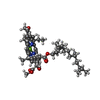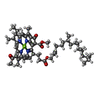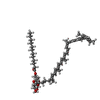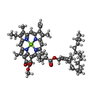+Search query
-Structure paper
| Title | Architecture of the photosynthetic complex from a green sulfur bacterium. |
|---|---|
| Journal, issue, pages | Science, Vol. 370, Issue 6519, Year 2020 |
| Publish date | Nov 20, 2020 |
 Authors Authors | Jing-Hua Chen / Hangjun Wu / Caihuang Xu / Xiao-Chi Liu / Zihui Huang / Shenghai Chang / Wenda Wang / Guangye Han / Tingyun Kuang / Jian-Ren Shen / Xing Zhang /   |
| PubMed Abstract | The photosynthetic apparatus of green sulfur bacteria (GSB) contains a peripheral antenna chlorosome, light-harvesting Fenna-Matthews-Olson proteins (FMO), and a reaction center (GsbRC). We used cryo- ...The photosynthetic apparatus of green sulfur bacteria (GSB) contains a peripheral antenna chlorosome, light-harvesting Fenna-Matthews-Olson proteins (FMO), and a reaction center (GsbRC). We used cryo-electron microscopy to determine a 2.7-angstrom structure of the FMO-GsbRC supercomplex from The GsbRC binds considerably fewer (bacterio)chlorophylls [(B)Chls] than other known type I RCs do, and the organization of (B)Chls is similar to that in photosystem II. Two BChl layers in GsbRC are not connected by Chls, as seen in other RCs, but associate with two carotenoid derivatives. Relatively long distances of 22 to 33 angstroms were observed between BChls of FMO and GsbRC, consistent with the inefficient energy transfer between these entities. The structure contains common features of both type I and type II RCs and provides insight into the evolution of photosynthetic RCs. |
 External links External links |  Science / Science /  PubMed:33214250 PubMed:33214250 |
| Methods | EM (single particle) |
| Resolution | 2.7 Å |
| Structure data | EMDB-30069, PDB-6m32: |
| Chemicals |  ChemComp-BCL:  ChemComp-SF4:  ChemComp-GS0:  ChemComp-F26:  ChemComp-F39:  ChemComp-LHG:  ChemComp-LMG:  ChemComp-CA:  ChemComp-G2O: |
| Source |
|
 Keywords Keywords | PHOTOSYNTHESIS / Photosynthetic reaction center / Green sulfur bacteria / Energy transfer |
 Movie
Movie Controller
Controller Structure viewers
Structure viewers About Yorodumi Papers
About Yorodumi Papers





 chlorobaculum tepidum (strain atcc 49652 / dsm 12025 / nbrc 103806 / tls) (bacteria)
chlorobaculum tepidum (strain atcc 49652 / dsm 12025 / nbrc 103806 / tls) (bacteria)